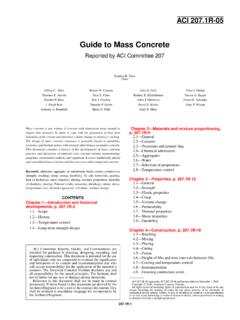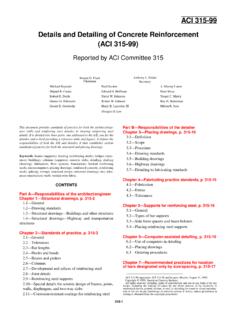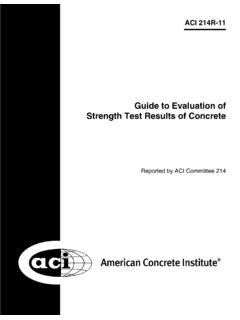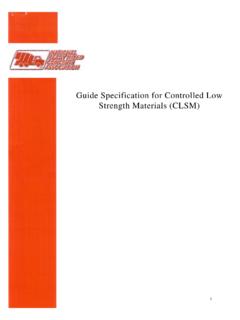Transcription of 350-01/350R-01 CODE REQUIREMENTS FOR …
1 ACI 350 Environmental Structures Code and CommentaryCharles S. HanskatChairmanLawrence M. TabatSecretaryJames P. Archibald*A. Ray FranksonM. Reza KianoushDavid M. RogowskyJon B. Ardahl Anand B. GogateDavid G. KittridgeSatish K. SachdevWalter N. BennettWilliam J. HendricksonNicholas A. LegatosWilliam C. SchnobrichSteven R. CloseJerry A. HollandLarry G. MrazekSudhaker P. VermaAshok K. DhingraWilliam IrwinJerry ParnesRoger H. WoodAnthony L. FelderDov KaminetzkyAndrew R. M. PhilipVoting Subcommittee MembersOsama Abdel-AaiClifford T. EarlyJack MollWilliam C. ShermanJohn BakerClifford GordonCarl H. MoonLauren A. SusticPatrick J. CreeganPaul HedliJaveed A. MunshiLawrence J. ValentineDavid A. CrockerKeith W. JacobsonTerry PatziasMiroslav VejvodaErnst T. CviklDennis C. KohlNarayan M. PrachandPaul ZoltanetzkyRobert E. DoyleBryant MatherJohn F.
2 Seidensticker*Past-Secretary of ACI 350 who served during a portion of the time required to create this document. Past-Chairman of ACI 350 who served during a portion of the time required to create this REQUIREMENTS FORENVIRONMENTAL ENGINEERINGCONCRETE STRUCTURES (ACI 350-01)AND COMMENTARY (ACI 350R-01)REPORTED BY ACI COMMITTEE 350 ACI Committee 350 Environmental Engineering concrete StructuresACI 350 Environmental Structures Code and Commentary318/318R-2 CHAPTER 1 INTRODUCTION350/350R-1 ACI 350 Environmental Structures Code and CommentaryThe code portion of this document covers the structural design, materials selection, and construction ofenvironmental engineering concrete structures. Such structures are used for conveying, storing, or treatingliquid, wastewater, or other materials, such as solid waste. They include ancillary structures for dams, spill-ways, and are subject to uniquely different loadings, more severe exposure conditions and more restrictiveserviceability REQUIREMENTS than normal building include normal dead and live loads and vibrating equipment or hydrodynamic forces.
3 Expo-sures include concentrated chemicals, alternate wetting and drying, and freezing and thawing of saturatedconcrete. Serviceability REQUIREMENTS include liquid-tightness or structures include conveyance, storage, and treatment design, materials, and construction of environmental engineering concrete structures are re-quired to produce serviceable concrete that is dense, durable, nearly impermeable, resistant to chemicals,with limited deflections and cracking. Leakage must be controlled to minimize contamination of ground wa-ter or the environment, to minimize loss of product or infiltration, and to promote code presents new material as well as modified portions of the ACI 318-95 Building Code that areapplicable to environmental engineering concrete structures. Because ACI 350-01 is written as a legal document, it may be adopted by reference in a general buildingcode or in regulations governing the design and construction of environmental engineering concrete struc-tures.
4 Thus it cannot present background details or suggestions for carrying out its REQUIREMENTS or is the function of the commentary to fill this REQUIREMENTS FOR ENVIRONMENTAL ENGINEERING concrete STRUCTURES(ACI 350-01) AND COMMENTARY (ACI 350R-01)REPORTED BY ACI COMMITTEE 350 ACI 350/350R-01 was adopted as a standard of the American ConcreteInstitute on December 11, 2001 in accordance with the Institute s standard-ization marks in the margins indicate the code and commentary changesfrom 318 Committee Reports, Guides, Standard Practices, and Commentariesare intended for guidance in planning, designing, executing, and inspectingconstruction. This Commentary is intended for the use of individuals whoare competent to evaluate the significance and limitations of its content andrecommendations and who will accept responsibility for the application ofthe material it contains.
5 The American concrete Institute disclaims any andall responsibility for the stated principles. The Institute shall not be liable forany loss or damage arising therefrom. Reference to this commentary shall notbe made in contract documents. If items found in this Commentary are de-sired by the Architect/Engineer to be a part of the contract documents, theyshall be restated in mandatory language for incorporation by the 2001, American concrete rights reserved including rights of reproduction and use in any formor by any means, including the making of copies by any photo process, orby any electronic or mechanical device, printed or written or oral, or record-ing for sound or visual reproduction or for use in any knowledge or retrievalsystem or device, unless permission in writing is obtained from the copy-right 350 Environmental Structures Code and CommentaryINTRODUCTIONThe code and commentary includes excerpts from ACI 318-95that are pertinent to ACI 350.
6 The commentary discusses someof the considerations of Committee ACI 350 in developingCode REQUIREMENTS for Environmental Engineering ConcreteStructures (ACI 350-01), hereinafter called the code. Emphasisis given to the explanation of provisions that may be unfamiliarto ACI 350 users. Comments on specific provisions are madeunder the corresponding chapter and section numbers of thecode and commentary is not intended to provide a complete histor-ical background concerning the development of the code, noris it intended to provide a detailed resume of the studies and re-search data reviewed by the committee in formulating the pro-visions of the code. However, references to some of theresearch data are provided for those who wish to study thebackground material in the name implies, Code REQUIREMENTS for Environmen-tal Engineering concrete Structures is meant to be used aspart of a legally adopted code and, as such, must differ inform and substance from documents that provide detailedspecifications, recommended practice, complete design pro-cedures, or design code is intended to cover environmental engineering con-crete structures of the usual types, both large and small, but is notintended to supersede ASTM standards for precast more stringent than the code provisions may bedesirable for unusual structures.
7 This code and this commen-tary cannot replace sound engineering knowledge, experience,and code for design and construction states the minimum re-quirements necessary to provide for public health and 350 is based on this principle. For any structure theowner or the structural designer may require the quality ofmaterials and construction to be higher than the minimum re-quirements necessary to provide serviceability and to protectthe public as stated in the code. Lower standards, however,are not 350 has no legal status unless it is adopted by governmentbodies having the power to regulate building design and con-struction. Where the code has not been adopted, it may serve asa reference to good code provides a means of establishing minimum standardsfor acceptance of design and construction by a legally appoint-ed building official or his designated representatives.
8 The codeand commentary are not intended for use in settling disputesbetween the owner, engineer, architect, contractor, or theiragents, subcontractors, material Suppliers, or testing , the code cannot define the contract responsibility ofeach of the parties in usual construction. General references re-quiring compliance with ACI 350 in the job specificationsshould be avoided, since the contractor is rarely in a position toaccept responsibility for design details or constructionThe commentary discusses some of the considerations of the committee in developing the ACI 350 Code,and its relationship with ACI 318. Emphasis is given to the explanation of provisions that may be unfamiliarto some code users. References to much of the research data referred to in preparing the code are givenfor those who wish to study certain REQUIREMENTS in greater chapter and section numbering of the code are followed throughout the the subjects covered are: permits, drawings and specifications, inspections, materials, concretequality, mixing and placing, forming, embedded pipes, construction joints, reinforcement details, analysisand design, strength and serviceability, flexural and axial loads, shear and torsion, development of rein-forcement, slab systems, walls, footings, precast concrete , prestressed concrete , shell structures, foldedplate members, provisions for seismic design, and an alternate design method in Appendix A.
9 The quality and testing of materials used in the construction are covered by reference to the appropriatestandard specifications. Welding of reinforcement is covered by reference to the appropriate AWS stan-dard. criteria for liquid-tightness testing may be found in and : Chemical attack; coatings; concrete durability; concrete finishing (fresh concrete ); concrete slabs, crack width, and spacing; cracking(fracturing); environmental engineering; inspection; joints (junctions); joint sealers; liquid; patching; permeability; pipe columns; pipes (tubes);prestressed concrete ; prestressing steels; protective coatings; reservoirs; roofs; environmental engineering; serviceability; sewerage; solid wastefacilities; tanks (containers); temperature; torque; torsion; vibration; volume change; walls; wastewater treatment; water; water-cement ratio; wa-ter supply.
10 Water 2001 Code REQUIREMENTS for Environmental Engineering concrete Structures and Commentary are present-ed in a side-by-side column format, with code text placed in the left column and the corresponding commentarytext aligned in the right column. To further distinguish the Code from the Commentary, the Code has been printedin Helvetica, the same type face in which this paragraph is set. Text marks in the margins indicate paragraphswith changes from ACI paragraph is set in Times Roman, and all portions of the text exclusive to the Commentary are printed in this type section numbers are preceded by an R to further distinguish them from Code section numbers. Text marksin the margins indicate paragraphs with changes from ACI 350 Environmental Structures Code and Commentaryrequirements that depend on a detailed knowledge of the de-sign.








![6ITSVXIH F] %'- 'SQQMXXII - dl.mycivil.ir](/cache/preview/4/b/b/f/2/e/8/1/thumb-4bbf2e81b2b2df04c22714e49f0954ce.jpg)


